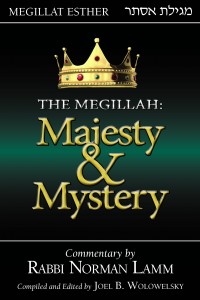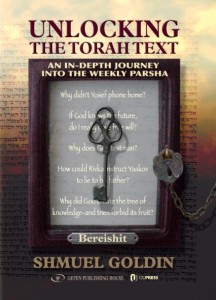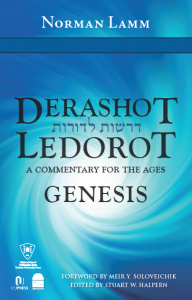Excerpted from Rabbi Norman Lamm’s ‘The Megillah: Majesty & Mystery’
 America, Bless God
America, Bless God
I am pleased to occupy a pulpit celebrated both because of its historic past and its present distinguished spiritual leadership in a congregation rightfully famous in our city. I am doubly happy because Shearith Israel is not only an illustrious synagogue, but also a good neighbor of my congregation, The Jewish Center. In this context, I prefer to translate the word she’arit of “Shearith Israel” not in its primary signification of “remnant,” but rather in its secondary meaning, as in the Biblical words she’er basar or sha’arah — “relative,” or “close friend.” For indeed both our congregations are part of the larger family of Orthodox Jewry on the West Side of Manhattan.
The Thanksgiving Day Services at the Spanish-Portuguese Synagogue are not only a fine patriotic gesture as loyal American citizens; they are also an authentic expression of Judaism. The source for this judgment is the Sephardi scholar of the late Middle Ages, Abudrahm. Why is it, he asks, that during the repetition of the Amidah by the cantor, the congregation joins him for only one blessing, in the course of which it expresses the same sentiments in modified language? Abudrahm was referring to the Modim blessing, for while the cantor chants the Modim, the congregation recites, in an undertone, the Modim de-Rabbanan. The reason for this, says Abudrahm, is that the other blessings consist of petitions for various benefits: We ask God for wisdom, health, prosperity, peace. Such prayers can be delegated to a representative of the congregation, which the cantor, in effect, is — the shaliah tzibbur. But when it comes to offering our thanks to the Almighty — and this is the essence of Modim — there, no delegation suffices, for the expression of gratitude is too personal, too intimate, too significant for substitutes.
In the same sense, when our fellow Americans repair each to his own house of worship to offer thanks to our Heavenly Father for the blessings of life, freedom, peace, and bounty which we enjoy in our beloved land, we Jews feel quite naturally obliged to turn to God and, in our own way, to thank Him. No real Jew can hear others say Modim and remain silent! The very name “Jew” derives from the expression of gratitude to God. The word derives from “Judea,” or from “Judah,” the fourth son of Jacob and Leah, who was named thus because ha-pa’am odeh et Hashem, “this time I will thank the Lord” (Genesis 29:35).
Yet it is not enough merely to approve of Thanksgiving Day. Judaism has, as well, an original approach to the phenomenon of gratitude that is analytic and profound in nature, and in which there is implicit a remarkable spiritual insight. We err if we imagine that the offering of thanks to God is a kind of religious courtesy, a form of spiritual politeness, of good manners to a good God. Thanks may be the sort of good taste that lubricates the machinery of human relations, but certainly God transcends the limits of cultivation and good breeding. The Merciful One desires the heart; God looks to the depths of a man’s soul and is unimpressed by ceremonial compliments. Surely the Lord prefers piety over polish, genuineness over gentility, the broken heart over the soft tongue. Obviously our thanks are not made to flatter God. What then does the Torah tradition mean when it emphasizes the importance of thanking Him?
I believe that the true Jewish conception goes to the existential roots of man himself. It addresses itself to the human situation in all its rawness and starkness, and to the human being in his anguished feelings of solitude, terror, and worthlessness. It tells us that an appreciation of God’s greatness must be accompanied and enhanced by an awareness and acknowledgment of our pettiness and inadequacy. True thankfulness is coupled with the knowledge that without God we would have nothing and be nothing. When we contemplate God’s greatness and beneficence, we realize our own worthlessness; and when we understand our own pettiness and inferiority, we begin to appreciate the divine perfection and the majesty of His loving-kindness. That is why we bow at the Modim prayer — in thanking Him for His goodness, we declare our own insufficiency.
The Hebrew language itself reveals this insight. The word hodayah means two things: thankfulness — and a confession of guilt. In line with this double meaning, one can give two parallel interpretations to the Modeh Ani prayer that we recite every morning. One is the usual translation, in which modeh is rendered as “I thank.” “I thank thee, O King, who lives and endures, who has mercifully restored my soul unto me; great is Your faithfulness.” The other would follow the second meaning of the word, thus: “I confess, or acknowledge, that as a human being I have no real sovereignty, I am mortal and frail; I keep myself alive only with the greatest difficulty, and often find myself sorely lacking in mercy and compassion; small is my faithfulness.”
When man sleeps he is unconscious, close to death, defenseless, prey to the terrors of the night and disease that stalks unseen, a potential victim of nature’s cruel whims. Modeh ani! In the special prayer of thanksgiving that we are obligated to recite upon deliverance from certain specific occasions of danger, the Birkhat ha-Gomel, we explicitly mention this same idea. We thank God ha-gomel la-hayyavim tovot, who bestows kindness upon the undeserving. God is good, we are undeserving: both elements are merged in one blessing. Here lies the true significance of thanksgiving in Judaism: the contrast between divine infinity and human finitude; between God’s eternity and our transience; His endless might and our helplessness; His all-encompassing wisdom and our pervasive ignorance.
Our gratitude is deepened when we face the fact that we are hayyavim, undeserving. For this reason, we American Jews are in a unique position to offer meaningful thanks to the Almighty.
Our hodayah consists of both the elements we mentioned. For it has already been pointed out that the Holocaust in Europe has left deep wounds on the collective psyche of American Jewry. We think of the precious individuals, families, and whole communities that perished in the flames that engulfed one-third of our people. What marvelous Jews, what sterling human beings they were! Can we in all honesty say that we are in any way superior to them? Yet, if not, why are we alive and they not? We know ourselves and we knew them. And we know that they were not deserving of their bitter fate, and that we are not deserving of any better destiny than they. It is a feeling of perplexity and also inner worthlessness, a knowledge of being undeserving of being saved, that informs our state of mind. We know that, comparatively, we are hayyavim — and therefore how much more grateful ought we to be to Almighty God for having spared us and our families! So our thanks to our Father in Heaven for this beloved haven called America stem from a unique historical experience and the cumulative vicissitudes of centuries. The distinguishing moral failure of the contemporary world, Jews no less than others, is that we have forgotten both elements: that God is gomel tovot and ought to be thanked, and that we humans are hayyavim. As a matter of fact, we have all but forgotten Him completely. Modern man contemplates his felicity, his abundance, his surpluses, and he thanks anyone but God except in his speech, and that is but a verbal vestige of ages past. He thanks his stockbroker, labor union, government, the UN, his own shrewdness or luck, or science and medicine, or mankind as such.
And here, speaking as an Ashkenazi rabbi to a Sephardi congregation, is an area where all Jews can benefit from the Sephardi historical experience, Let me explain by referring to a law codified in the Shulhan Arukh (Orah Hayyim 219). We mentioned before the special thanksgiving prayer, the Birkhat ha-Gomel. One of the four occasions when this prayer is mandatory is after one has safely crossed the midbar, the desert or wilderness. Here the author of the Shulhan Arukh notes a divergence between Ashkenazi and Sephardi practice: In Germany (Ashkenaz) and France, he writes, the practice is not to recite the blessing when journeying from city to city, for it was intended only for those who travel in the desert, which is frequented by hayyot ra’ot, wild beasts, and listim, bandits. However, in Spain (Sepharad) the custom is that we do recite the blessing, because all the highways are presumed to be dangerous.
No doubt historians will find good historical reasons for this difference in religious practice. Probably intercity traffic in Spain was far more dangerous than in Germany and France, where highway robbery was less frequent. Yet there is more than a sociological difference between them. The commentators see a halakhic principle in issue. And even more the difference in approach has a larger significance; it is a parable for modern men. For modernity was born in Ashkenaz, in Germany and in France, the whole modern cast of mind, the contemporary celebration of human might and ingenuity and independence from God, the age of humanism — these were sired by the French Revolution and German Enlightenment. Here there took place the collective apotheosis of man, and the dethronement of God. And all too many of us Jews went along with the tide. We hailed the Encyclopedists as our prophets, Goethe as our psalmist, and Marx as our messiah. We all but cried out, “Science is my shepherd, I shall not want …” We deluded ourselves with that nineteenth-century tranquilizer called “progress.” We thought we had conquered the midbar and had substituted for it the city, symbol of human achievement. Our journey was from city to city, from one level of culture and civilization to another yet higher. We were making “linear progress” and there was nothing or no one who would or could impede us. With the midbar of life and the world vanquished, we were confident that we no longer had any reason to fear the “wild beasts” and “bandits” that once afflicted the human race. Universal peace and justice were, after all, just around the corner — thanks to
man’s new ways and great knowledge.
We forgot the experience of the Sephardi Jews. We should have learned from them that you can have a Golden Age and great universities and cultural centers, Barcelonas and Toledos and Cordovas — and yet, so short a time afterwards, expulsions, dispersions, and inquisitions! We should have learned this — but we did not. We ignored the fact that where there is no sense of submission and responsibility to a Higher Power, there are can be no occasion for gomel, for there are no tovot. And where there is no thankfulness to God, where there is no humility, there man becomes ruthless, he turns into bandits, and all of society abounds in wild beasts.
We of the twentieth century thought that all the world was one “city,” one giant, united, cultural human unit. Then suddenly, and to our dismay, we learned that it was really only a midbar, a desert, and that the vision of a civilized city was just another mirage in the wide, terrifying desert. We discovered that we were prey to the wild beasts of Hitler and Mussolini, and that decent men and women were being victimized by the international bandits operating out of the Kremlin and Cairo. Oh, how we looked for new ways, new derakhim! We tried the “scientific way of life” — and discovered not only penicillin and radio, but also nuclear bombs, fallout, and leukemia. We thought nationalism was the best way and learned that with independence can come new tyrannies undreamed of, and terror more fierce than ever imagined. We tried the way of humanism and found that the ringing declarations soon hung like limp clichés, leaving our youth rootless, psychologically unstable, devoid of ideals or enthusiasm, interested in nothing but themselves — and these selves were morally diminutive.
Kol ha-derakhim be-hezkat sakkanah, as our Sephardi scholars taught: Where there is no Godliness, where man arrogantly asserts his absolute independence, all ways are corrupt and dangerous. Where man fails to acknowledge that he is of the hayyavim, where he maintains that he is guiltless and master of his own destiny and need not thank the divine gomel tovot, his ways wind through wilderness and wasteland, and he is at the mercy of the bandits and the wild animals. What we learn, therefore, is a marvelous paradox: When man begins with self-assertion and self-confidence, he ends with self-destruction and annihilation; when he begins with self-abnegation and distrust, he ends with a ringing self-affirmation and ennoblement.
It is this thoroughly Jewish idea — the dual nature of hodayah and the inexorable failure and mortal danger of human ways without God that should be our specific Jewish contribution to the American experience of Thanksgiving. It is for this reason that, to my mind, Thanksgiving Day is so much more precious than other national holidays. Other patriotic occasions, such as Independence Day, valuable though they are, can easily degenerate into national self-idolatry and collective self-glorification. In order to reestablish the proper harmony we need the kind of corrective of humility inspired by Thanksgiving Day. For if July 4th is Independence Day, then Thanksgiving is our Dependence Day — our dependence upon the Almighty. Let this, then, be our prayer: Almighty God, as we rely upon Thy guidance, recognizing our unutterable debt to Thee as hayyavim. You lead us out of the midbar, spare us from the listim who would unleash unspeakable terror upon all men, and from the hayyot ra’ot that lurk unpredictably in the hearts of each of us. May all our derakhim (ways) be safe from sakkanah (danger), and may they all lead to a greater and better future for all of us, all America, and all mankind.
For all this we thank You, O Lord. And even as during the rest of the year we pray “God, bless America,” today we turn to our own hearts and to the soul of our country and declare, “America, bless God.”




